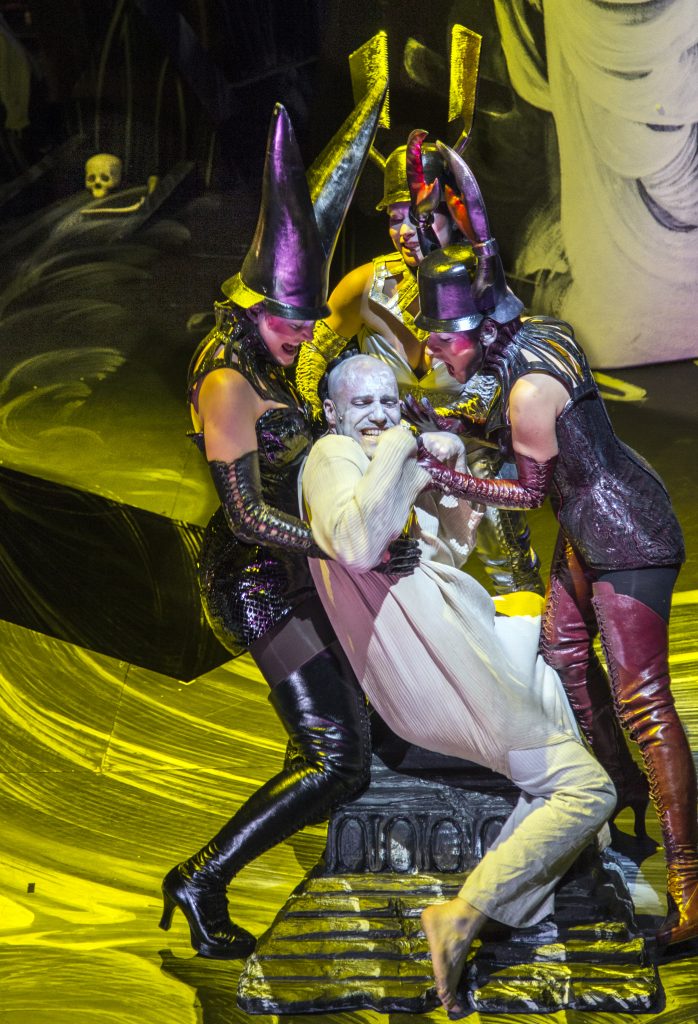Helen Westerik gaat in op de vormgeving van deze opera.
Componist Louis Andriessen, regisseur Pierre Audi en librettist Helmut Krausser zetten een grote international coproductie neer in een decor van de Quay tweeling. Reden om te kijken hoe deze broers, bekend geworden met hun stop motion animaties, hun werk naar zo’n grote schaal vertalen. Als slechts één onderdeel van een groot en complex geheel, hoe blijft hun werk en identiteit dan staan?
De Quays maken al decennia lang hun volstrekt eigen films in hun unieke filmtaal. Hun – meest korte – films spelen zich af in microkosmosjes die duister en mysterieus zijn, maar waar je evenwel graag een weekje in zou willen toeven om echt door te dringen tot hun geesteswereld.
Andriessen wilde met hen werken omdat hij in hen een hedendaagse pendant zag van Athanasius Kircher, de renaissanceman, charlatan, uitvinder en alleskunner waarop de opera is gebaseerd. En op hun beurt zijn de broers zonder meer geinspireerd door visuele werk van Kircher. Een match made in heaven?
In een werk met een fragmentarisch libretto in meerdere talen werkt de vormgeving als een leidend element. Ook de kostuums, met name de exoskelet-corsetten van de drie heksen, geven een dramatische lading die het libretto soms mist. Het maakt duidelijk waar we soms even dreigen te bungelen, het geeft samenhang.
In het kostuumontwerp van Florence von Gerkan vallen met name de kostuums voor ‘de jongen’ op. Hij krijgt nergens een naam. Op zijn met buttons behangen bomberjack staat achter op “Boy”, in een latere scene wordt het een soort Robin (van Batman), om te eindigen met duivelshoorns. De rol van die jongen, prachtig vertolkt door Lindsay Kesselman, krijgt hierdoor extra zegginsgkracht. De uitgever heeft een cape van een soepel soort rubber. Deels Zorro, deels SM-kelder, het illustreert de vreemde verhouding die hij met Kircher heeft en geeft hem een adderachtige uitstraling.
Vortex
Een postmoderne opera, met postmoderne kostuums, soms grotesk, soms historisch, soms zoals een batman-shirtje, bijna afkomstig van het Waterlooplein, maak daar maar eens een décor voor.
In Carré vinden de Quay Brothers in ieder geval een mooi theater om in the werken. De piste is omgebouwd tot een speelveld dat doet denken aan het Joodse kerkhof in Praag door de paar schotse en scheve graven: een sfeer die zowel poëtisch als melancholisch is. Centraal staat een gekromde pilaar, een soort vortex die zich naar de hemel uitstrekt. Later blijkt dat de toren van Babel te zijn.
Het licht bij aankomst in de zaal is sober zwart-wit, evenals het décor in de piste. Het is zoveel logger en groter dan het werk in de films van de Quays, dat ik een lichte teleurstelling niet kon onderdrukken. Zou het dan echt doodslaan bij deze schaalvergroting?
Maar dan zijn er gelukkig de achtergrondprojecties. De toneelopening van Carré wordt bijna helemaal gebruikt voor die projecties op semi-transparant doek. Soms illustratief, soms becommentariërend, soms autonoom: het verhaal van de opera en de levensloop van Kircher zijn te zien in schaduw- en stop-motion animaties. Het groteske uit de ondertitel komt hier heel duidelijk naar voren: duveltjes uit doosjes schetsen een mysterieus, speels en duister beeld tegelijk.
Spectaculair is de verschijning van Sor Juana Ines de la Cruz, een Mexicaanse mystica waarmee Kircher gecorrespondeerd heeft. Op het podium, achter het eerste doek schuift ze op een heen en weer bewegende verhoging langs, als een levensgrote reliekenkast: ze heeft een verlicht lijstje met een portret op haar borst. Het geeft een surrealistisch beeld van religie als vorm, als kitsch, maar ook verheven en afgebakend. Een mooi beeld voor de enige vrouw in het leven van Kircher. Omdat het portretlijstje verlicht is, lijkt haar hart in brand te staan. Voor hem?
Belofte
Gaandeweg komt er ook meer kleur, en dus meer zeggingskracht, in de piste. Het grauwe gaat weg, waardoor het toneelbeeld meer diepte krijgt en het iets minder storend is hoe netjes alles is. Er zitten geen deukjes in de decorstukken, er ligt geen stof. Alles ziet er vers geverfd uit. Maar als er één ding aantrekkelijk is aan het werk van de Quay broers, is het dat iedere losgeraakte schroef, ieder hoopje stof en iedere half verbande pop een belofte inhoudt. Je herontdekt de schoonheid van piepende scharnieren en ijzerzaagsel. En dat valt nu eenmaal niet te vertalen naar een grote schaal.
Gelukkig maken ze dat meer dan goed met de animaties en de prachtige vondst van het bewegende podium voor Sor Juana. Zeker de animaties die het slot van de voorstelling en het leven van Kircher inluiden zijn prachtig.
Ik hoorde om me heen wat gemopper op het libretto. Maar over de vormgeving kunnen we het eens zijn. Die smaakt naar meer.
Voor kaartjes en meer informatie klik hier.
Bewaren
Bewaren

